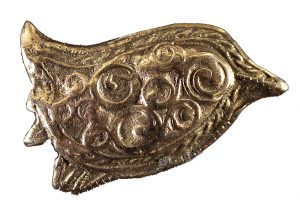Daniel Breen describes a lovely artefact from Cork Public Museum
 The Garryduff gold bird has a special connection with Cork Public Museum. Not only was it unearthed in the same year as the Museum’s opening but also the excavation was headed by our first curator, M.J. O’Kelly. During the summers of 1945 and 1947, O’Kelly excavated two ringforts on a small hill located between Fermoy and Midelton. The bird, found at Garryduff I, is the only gold find from a dig that yielded a significant number of objects of varied typology. The site occupies a commanding position over the surrounding locality, offering ready access to the eastern part of Cork harbour, its rich agricultural hinterland and the extensive river systems of the Bride and the Blackwater.
The Garryduff gold bird has a special connection with Cork Public Museum. Not only was it unearthed in the same year as the Museum’s opening but also the excavation was headed by our first curator, M.J. O’Kelly. During the summers of 1945 and 1947, O’Kelly excavated two ringforts on a small hill located between Fermoy and Midelton. The bird, found at Garryduff I, is the only gold find from a dig that yielded a significant number of objects of varied typology. The site occupies a commanding position over the surrounding locality, offering ready access to the eastern part of Cork harbour, its rich agricultural hinterland and the extensive river systems of the Bride and the Blackwater.
O’Kelly’s excavation report, published in 1963, reveals a skilfully constructed ringfort with a substantial entrance, at least two houses and two separate but probably close periods of occupation. The abundance of objects illuminates an early medieval community (seventh/eighth centuries) made up of farmers and hunters alongside artist-craftsmen. Aside from a couple of spearheads, O’Kelly found no trace of military activity and concluded that the inhabitants of Garryduff I were a peaceful but well-off community dedicated to their craftwork. Though signs of metalworking and craft activity have been found on other Irish secular sites of this period, the abundant evidence for the production of higher-grade metal and glass suggests that Garryduff I was a higher-status or ‘royal’ site.
Symbolic of this status is the exquisite gold bird—a tiny object (1.5cm) associated with the earliest occupation layer and dated stylistically to the late sixth or seventh century. Its shape, proportions and upturned tail indicate that it is a depiction of a wren. It was ingeniously made by manipulating a thin foil of metal to resemble a bird’s body. Fine ornamental gold wirework, known as filigree, was expertly laid on the foil’s surface, giving the bird its features. The craftsperson employed a decorative style reminiscent of the Iron Age La Tène, while the filigree techniques and the object’s form point to more contemporary stylistic influences from Anglo-Saxon, Frankish and Lombardic territories. The Garryduff gold bird therefore offers a tiny example of how a small east Cork community was able to thrive and flourish by producing major works of art in various media that utilised the best craft traditions of the Irish and European early medieval period.
This is part of an article that appears in the Spring 2018 issue of Archaeology Ireland on the Cork Public Museum.
